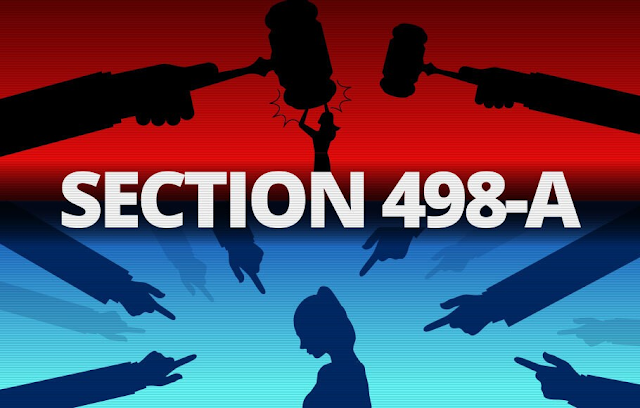Misuse of Section 498-A Cr.P.C
There is a phenomenal increase in matrimonial disputes in recent years. The institution of marriage is greatly revered in this country. Section 498A of the Indian Penal Code was introduced with the avowed object to combat the menace of harassment to a woman at the hands of her husband and his relatives. The fact that Section 498-A is a cognizable and non-bailable offense has lent it a dubious place of pride amongst the provisions that are used as weapons rather than shields by disgruntled wives. The simplest way to harass is to get the husband and his relatives arrested under this provision. In a quite number of cases, bed-ridden grand-fathers and grand-mothers of the husbands, their sisters living abroad for decades are arrested.
Section 498A in The Indian Penal Code
[498A Case. Husband or relative of husband of a woman subjecting her to cruelty. — Whoever, being the husband or the relative of the husband of a woman, subjects such woman to cruelty shall be pun¬ished with imprisonment for a term which may extend to three years and shall also be liable to a fine. Explanation. — For the purpose of this section, “cruelty” means —
(a) any wilful conduct which is of such a nature as is likely to drive the woman to commit suicide or to cause grave injury or danger to life, limb, or health (whether mental or physical) of the woman; or
(b) harassment of the woman where such harassment is with a view to coercing her or any person related to her to meet any unlawful demand for any property or valuable security or is on account of failure by her or any person related to her to meet such demand.]
The Supreme Court endeavored in its judgment (Arnesh Kumar vs. State of Bihar (02.07.2014 - SC) to ensure that police officers do not arrest accused unnecessarily and Magistrate do not authorize detention casually and mechanically and thus gave the following directions –
(1) All the State Governments to instruct their police officers not to automatically arrest when a case Under Sec 498A of the Indian Penal Code is registered but to satisfy themselves about the necessity for arrest under the parameters laid down above flowing from Section 41, Code of Criminal Procedure;
(2) All police officers be provided with a checklist containing specified sub-clauses Under Section 41(1)(b)(ii);
(3) The police officer shall forward the checklist duly filed and furnish the reasons and materials which necessitated the arrest while forwarding/producing the accused before the Magistrate for further detention;
(4) The Magistrate while authorizing detention of the accused shall peruse the report furnished by the police officer in terms aforesaid and only after recording its satisfaction, the Magistrate will authorize detention;
(5) The decision not to arrest an accused, be forwarded to the Magistrate within two weeks from the date of the institution of the case with a copy to the Magistrate which may be extended by the Superintendent of police of the district for the reasons to be recorded in writing;
(6) Notice of appearance in terms of Section 41A of the Code of Criminal Procedure be served on the accused within two weeks from the date of institution of the case, which may be extended by the Superintendent of Police of the District for the reasons to be recorded in writing;
(7) Failure to comply with the directions aforesaid shall apart from rendering the police officers concerned liable for departmental action, shall also be liable to be punished for contempt of court to be instituted before High Court having territorial jurisdiction.
(8) Authorising detention without recording reasons as aforesaid by the judicial Magistrate concerned shall be liable for departmental action by the appropriate High Court.
Similarly, the Hon’ble Supreme Court in R.P. Kapur v. State of Punjab AIR 1960 SC 866 summarized some categories of cases where inherent power can and should be exercised to quash the proceedings:
(i) where it manifestly appears that there is a legal bar against the institution or continuance of the proceedings;
(ii) where the allegations in the first information report or complaint taken at their face value and accepted in their entirety do not constitute the offense alleged;
(iii) where the allegations constitute an offence, but there is no legal evidence adduced or the evidence adduced clearly or manifestly fails to prove the charge.
Thus there are various safeguards in place to prevent the misuse of section – 498 A of the Cr.P.C. as such malicious criminal trials lead to immense suffering for all concerned. Even ultimate acquittal in the trial may also not be able to wipe out the deep scars of the suffering of ignominy.




Comments
Post a Comment